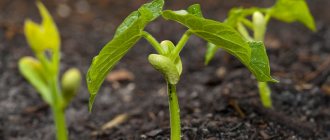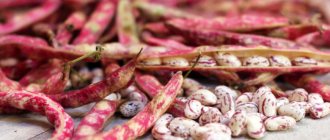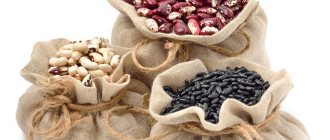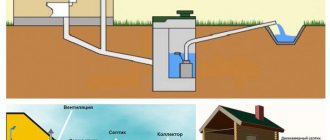OgorodGuruCom
Tips and tricks for gardeners
Popular
Varieties of climbing edible beans - purple, white, asparagus and Spanish
Home › Vegetables › Development of beans - description of the main stages of the life cycle
Beans are considered a popular member of the legume family. It is a heat-loving and sensitive plant. However, most gardeners can grow crops in the middle zone. Beans have different structures. Its fruits differ in taste, color, and features of use. To successfully grow crops in the garden or at home, it is important to study the formation features and stages of bean germination.
Bean sprouting experience
Elena Aleksandrovna suggested that we conduct an experiment on germinating beans at home, record the results of the experiment and prepare a report based on them. We decided to go further and prepare an online report from the scene of the events. Meet us! “Fa-fa-sol” or “Where life begins”!
Beans (lat. Phaséolus) are a type genus of plants of the Legume family, uniting about 87 species growing in the warmer regions of both hemispheres. They are bred for their fruits and seeds – and some species also for their flowers. Of the cultivated species, the first place is occupied by the common bean with many varieties and varieties, some of which are climbing, others are bush. The homeland of this species is Latin America.
Why are beans sprouted?
Adherents of proper nutrition recommend eating sprouted sprouts of various crops, including beans. They contain a large amount of vitamins and microelements necessary for the body. The food used is small green mung beans called peas. Salads, stews, and cutlets are prepared from it. The procedure for sprouting beans is carried out for several reasons:
- When sprouting, sugars that contribute to bloating are decomposed.
- The amount of healthy protein in grains increases by 30%, the amount of carbohydrates decreases by 15%.
- The carcinogen aflatoxin is deactivated.
- The number of enzymes increases 100 times.
- Eating bean sprouts helps eliminate toxins.
If the legume crop is not used for eating raw, but as planting material, germination will help the seeds germinate quickly. The gardener will be able to harvest the harvest earlier than when planting beans without sprouts.
Part I: Preparation
For the experiment, we chose red bean seeds to see how the color of the seeds would change during the germination process. We measured the beans and looked inside
Get a 25% discount and an additional cashback of up to 30% on the wholesale price of the product!
More details
The beans bought at the nearest store turned out to be approximately the same size, about one and a half centimeters. Each of them can be split into two halves - cotyledons - these are nutrients for the future sprout until it gets stronger. The photo shows a plant embryo with a pair of leaves. The cotyledons and embryo are covered with a dense membrane. The inside of the cotyledon is the same color in both white and colored beans. The only difference is the color of the shell and the size of the beans.
We will have three samples participating in the experiment: Sample 1 - will simply lie in the light and heat. Sample 2 – will lie in a glass of water. Sample 3 – will lie on a piece of cotton wool moistened with water. Thus, we will find out which conditions are best for bean germination.
Possible difficulties when growing beans at home.
When, after the parent meeting, we began to share our impressions of germinating seeds, it turned out that not everyone could wait for the roots. I was wondering why the bean seeds don't germinate.
Reason 1 . The teacher explained this by improper storage of the beans themselves: in sealed packaging. In addition, some of them had beans from the supermarket, and who knows what the beans are treated with in stores so that no one gets caught in them or so that they don’t go to waste.
We buy beans from trusted sellers at the market. And although they sell for food, and not for sowing... but after planting their products, everything sprouted: beans, mung beans, and popcorn))) They always store legumes in bags. With access to oxygen. Although... the hermeticity theory is questionable, because mung beans, stored in a bag for six months at our house, sprouted just as easily. This means that there are other reasons why beans do not germinate.
Reason 2. Dried or rotten seeds. Of course, they are unlikely to germinate. So for planting, choose strong beans with a smooth, intact shell and a generally healthy appearance.
Reason 3. Seeds are too old. Yes, the longer the beans are stored, the less chance they have of germination. Fresh beans sprout very quickly. We saw it))) So, perhaps, it’s worth purchasing beans for seeds in a specialized store.
Reason 4 . The beans are damaged by bugs or disease. It's not always immediately noticeable. But when it swells, all this will come out into the light.
Reason 5. No oxygen available. This is when they took and completely filled the seed with water. Instead, there is a chance of getting mucus on the surface rather than sprouts. Beans love water, but they love air no less. So everything in moderation.
In addition, after planting a sprouted seed, there is also a small risk that the beans will not grow. Why?
- Perhaps the roots broke off during planting.
- The room is too cold or the soil is too dry. It is imperative to monitor the humidity and prevent drying out, especially near hot radiators. But again, do not be fanatical, otherwise mold may develop on the surface. And beans love warmth and grow much faster in a warm kitchen than on a cold balcony.
- Low nutrients or too dense clay soil. I noticed that indoor plants generally do not grow normally in soil from the garden; it is too dense for them. The roots of beans also love access to air (although if you plant them in the garden, they will have to grow and not be capricious, but at home...))))). Therefore, the soil must be “diluted” with peat or compost. Well, you can fertilize it a little.
The first day
The first day has passed. There are no visible changes in sample No. 1. The beans in sample No. 2 increased in size to two centimeters, and the color became paler. In sample No. 3, the beans also increased in size. On the side in contact with the wet cotton wool, the beans swelled more and the color became pale, as in the 2nd sample.
We cut the bean from the 3rd sample and immediately noticed that the root of the embryo became thicker and the leaves increased in size. The bean skin has become softer.
How to germinate mung bean
Mung beans are small green beans. We used to call it peas. The principle of germinating mung beans is not much different from beans. Pea sprouts are consumed as a main dish, salads, stews and even cutlets are prepared from it. This product is extremely beneficial for the body.
Note! For germination, only fresh mung bean harvest is used. Otherwise, the beneficial properties of the sprouts are significantly reduced.
In order for mung bean to germinate, it must first be soaked in cold water. After 10 hours, the peas are removed, washed and filtered through a sieve. Soaked beans will become softer and increase in volume, which will speed up the emergence of seedlings.
The best way to germinate mung beans is in a small plastic bucket with holes drilled in it. This will prevent excess water from being in the container, which could cause the grains to turn sour.
Dry gauze is placed at the bottom of the bucket. Grains are poured on top of it and sprinkled with water. Then they are covered with a cloth and placed in a dark place for a day. Every 2-3 hours you need to add a little water to the mung bean. Within a day, small sprouts will appear, which can be eaten immediately or left for another 2-3 days to achieve greater length.
Second day
The second day has passed. We didn't see any big changes. The 1st sample has not changed at all. The 2nd and 3rd samples increased slightly. The water turned slightly pinkish from the bean skin dye. We cut the bean from the 3rd sample. The root of the embryo became a little larger and, after cutting the peel, began to stick out a little to the side.
Care after landing
Beans do not require much attention and any type grown in beds will bear high-quality fruits, but one planting is not enough to grow them.
One of the main priorities in sprouted crops is proper watering. It should be done not too often, in moderation, and preferably in the morning. It is necessary to moisten between the rows, otherwise water will get on the leaves and fungal diseases may appear. For green beans and decorative watering, watering should be carried out throughout the whole season, since its deficiency leads to drying of the seedlings, which will not have a very beneficial effect on the quality of the crop. Stagnation of water is also harmful and risks causing the growth of leaves to become uncontrolled, which will lead to their rotting.
It would be a good idea to monitor the condition of the soil: clear it of weeds and loosen it with a hoe, since the roots need access to air. But you need to make sure that the tool does not damage them. If yellow spots appear on the leaves, then the plant does not have enough potassium. Its deficiency leads to bacterial diseases; to prevent this from happening, wood ash is sprinkled on top of the beds.
Day three
The third day has passed. And in our third sample, two beans hatched! The first and second samples are still without visible changes.
Day four
In the third sample, two more beans hatched! Yesterday's roots had greatly increased in size, and the skin around them began to tear. The first and second samples are still without visible changes.
Day seven
The first part of our experiment has come to an end. The first sample, which was kept warm but without water, did not germinate. The second sample, which was completely immersed in water, increased in size, but did not produce a single shoot and the water deteriorated. And only in the third sample, which was lying on a damp cotton wool, beans sprouted, and one grew especially strongly and even sent out lateral roots.
conclusions
As a result of our experiment, we saw that some of the seeds that were simply lying in the light remained unchanged. Those that lay in the water did not sprouted, but died. Those seeds that were on cotton wool moistened with water gave early and friendly shoots. Thus, we concluded that water, air, and heat are necessary for the development of the seed. While working on the project, we learned how a seed works. It consists of a seed coat, cotyledons and an embryo. The seed coat protects the seed from damage and drying out. The cotyledons contain nutrients for the embryo. And the embryo gives life to a new plant.
Practical work for 5th grade students.
Work can be done at home, if desired, for additional assessment.
You will need: potatoes (raw), some flour, gauze, sunflower seeds (you can take pumpkin seeds, sesame seeds, pine nuts or other oily seeds), a knife, a bowl of water, a sheet of paper. Title of the work “Organic substances of plants”
Purpose of the work:
to detect organic substances in plant material. Operating order (table):
- 1. Take a lump of dough (it is made from plant seed flour, therefore, has the same chemical composition), put it in a gauze bag. Rinse the dough well in water poured into a glass.
2. A viscous sticky mass remains in the gauze - gluten. Gluten is similar in composition to chicken egg white and is called vegetable protein.
3. Add 2-3 drops of iodine to a glass of cloudy water in which the dough was washed. What are you observing? Drop iodine onto a cut potato tuber. What are you observing? It is known that when interacting with iodine, starch acquires a blue color. Draw a conclusion.
4. Place sunflower seeds (or other oilseeds) on the paper and crush them. What appeared on the paper? What substance was released?
5. Fill out the table
| What are you observing? | |
| 1. Wheat flour | Placed in gauze and washed in water |
| 2. Cloudy water after washing flour | |
| 3. Potato tuber cut | |
| 4. Sunflower seeds | Crushed on paper |
6. Conclude:
what organic substances are included in plants.
myblog-bio.blogspot.com
Part II: Germination
Our experiment does not end here. Now we have to find out what conditions are necessary for a young sprout to turn into a full-fledged plant. To do this, we selected sprouted beans from the third sample. We divided them into three groups. We placed the first group, together with the largest sprout, in a glass jar so that we could observe the growth of the root through the side wall. We will place this sample in a warm and bright place. We will place the second group next to the first, but cover it with a lid, i.e. deprive access to sunlight. We will place the third group in a sunny place, but on a cold windowsill, i.e. in a place where there is less heat than the first and second samples. We will observe which group of seeds will develop better.
Basic methods of germination
Beans are sprouted both for consumption and for planting in open ground. Each option has its own nuances.
How to quickly sprout beans for food
There are several ways to germinate legumes for food. With any of the methods, the grains swell overnight, and after 1-2 days the first seedlings appear. First, the seeds are soaked in water for several hours, then germination will occur faster.
In damp cloth
The beans are laid out on a moistened material and covered with the same layer of cloth. Every 2-3 hours, the legume is moistened with water from a spray bottle. When moistening, you need to make sure that there is no excess liquid on the surface. Because of this, the seeds stop breathing and may become moldy.
In a glass container
Sprouting beans in a glass container at home in stages:
- The washed seeds are placed in a glass jar.
- Cover the container with damp gauze or other cloth.
- Then the dishes with beans are placed in a warm place.
Twice a day - morning and evening, the beans need to be washed, then put back into the jar. When using this method, there is no excess moisture in the dishes, as a result of which heat exchange is not disrupted and the seeds do not become moldy.
On cotton pads
First, cotton pads or balls are placed in the dishes, and beans are placed on them. Everything is moistened with a small amount of water. The container is placed in a warm place. Seedlings appear the next day.
Germination of bean material for planting in the ground
For planting in the ground, several options for soaking seeds are also used. Germination begins after 2 days. The grains begin to germinate a few days before planting in open ground. First, they are washed, soaked for several hours in water, then in a weak solution of potassium permanganate to prevent fungal diseases.
In a rolled-up cigarette
The procedure is performed as follows:
- A roll of toilet paper is spread on the film, which is then sprayed with water from a spray bottle.
- The beans are laid out at a distance of several centimeters from one another.
- A layer of paper is laid on top, which is then moistened.
- The film is rolled up and the bottom edge is dipped into water.
After a few days, the beans are ready for planting.
In the dishes
For germination, use a colander, deep bowl, and gauze. The procedure is performed as follows:
- Gauze is placed inside the colander.
- seed spills out.
- The top of the beans is covered with gauze.
The legume crop is watered from above with water, the excess of which flows through the holes into the bowl. You need to make sure that the gauze on top is wet all the time.
In peat pots
Young seedlings do not tolerate transplantation well, so beans can be planted in peat pots with moist soil. When they grow up, they are planted in open ground along with pots. As peat decomposes, it will serve as additional nutrition for the root system.
School experiences
In a biology lesson, schoolchildren conduct various experiments, one of which is the correct sprouting of beans. To do this, use a nylon lid, cotton pads, and beans from the store. Germination procedure step by step:
- Wet discs are placed in the lid.
- Then the grains are laid out in one layer.
- The beans are covered with cotton pads, which are moistened with water.
You need to ensure that the discs are kept wet at all times, but without stagnating liquid. Within a couple of days, sprouts will appear.
The first day
One day has passed since the sprouted beans were planted in the ground. There are no big changes yet. We planted the beans shallowly, so it is possible that the beans were slightly exposed as a result of the heavy watering.
Bean care
As soon as the beans sprout, the bed is watered with water, then the soil is loosened. The procedure is carried out carefully so as not to damage the fragile seedlings. Subsequently, loosening is combined with weeding. Water the beans so that the soil is moist but not wet. Moisture is especially needed during the formation of pods. 25-30 days after seed germination, young plants are fed with complex mineral fertilizer. The next feeding is after 20 days.
To prevent plantings from being affected by fungal diseases, it is necessary to observe crop rotation, disinfect seeds, and burn infected bushes.
Pests in the form of snails and slugs are collected by hand. Climbing varieties of beans need to be tied to supports so that they do not break from the wind.
Note! Before fertilizing the planting, it is spilled with plain water, otherwise the delicate roots may be burned by the salts.
Second day
Yesterday, when we photographed the first sample, a tiny edge of a bean could be seen between the lumps of earth. And this evening a sprout 8 cm high grew in this place! It's amazing! Such progress in just one day of light! The first pair of leaves are well formed and ready to open. The cotyledons began to shrink. In the second and third samples, the beans barely emerged from the ground. The development of sprouts occurs with a noticeable lag.
Selection of location and soil
To properly germinate bean sprouts, they need to be planted on light and neutral soil. Seeds cannot be germinated in soil enriched with nitrogen, since the plant’s tuber system reproduces it itself. If the soil looks crumpled, it needs to be loosened or agents added to help loosen it.
Since beans are a heat-loving crop, it is worth choosing a planting site on southern slopes and where there is little chance of blowing. In such areas, the ground will be sufficiently warmed up and will have greater access to heat, even on a cold night. In dark places, the sprouts do not stop developing, but germinate at a slower pace and, as a result, ripening is late.
Day three
The first sample exceeded all our expectations. During the night it rose another 5 centimeters, and during the day the first pair of leaves unfurled, the leaves became larger and the color darker. Between the first pair of leaves there was a sprout for further growth. Through the glass of the jar, the elongated roots of the white plant are visible. In the second sample, the bean barely rose in the ground. Compared to the first sample, the lag is two days. The third sample never changed.
How to quickly germinate beans
For the speedy emergence of sprouts, it is important not to allow the tissue in which they are located to dry out. Varieties such as mung bean are pre-soaked in water, which significantly speeds up the appearance of sprouts. To get the desired result overnight, growth stimulants are used, which are combined with water. In this case, the first shoots will be ready for planting the very next day.
The easiest way to sprout beans for eating is to place the beans in a damp cloth. As a rule, after one or two days the sprouts are ready to eat.
Day four
In the first sample, the first pair of leaves increased. The cotyledons gradually dry out and are about to fall off. The root system has grown and filled the free space in the jar. The sprout in the second sample was never able to rise above the ground. In the third sample, growth stopped completely.
conclusions
For plant growth, it is very important that there is plenty of sunlight, warmth and moisture. When all three conditions are met, the sprout very quickly strengthens in the soil and opens its leaves in a matter of hours. From this moment on, the plant can independently obtain nutrients and water through the root system and obtain energy through photosynthesis in the leaves.
Look in fast motion at how our sprout grew. First, it grew roots, absorbed moisture and nutrients from the soil, and then quickly developed a strong stem with the first pair of leaves.
Bean seed germination
The development of beans from seed to adult plant has a number of features. The optimal temperature for seed germination is +15…+26 degrees. In more severe conditions, seed germination deteriorates and pod development is disrupted.
It is important to choose the right timing for planting this crop. It is best to do this a week after the threat of frost has passed. It is recommended to plant beans at intervals of 5-7 cm. This helps provide them with optimal nutrition and sufficient space.
Important! It takes an average of 2-3 months for beans to reach full maturity. In this case, the specific period is determined by the variety, climatic conditions, and soil conditions.
Beans need moist soil that has good drainage. In this case, the pH parameters should be 6-7.2. Untreated soil or high humidity can cause beans to rot.
It is important to ensure that the soil does not have a high ability to retain moisture. Excess water can cause the grains or sprouts to rot. Don't use too much fertilizer. This plant does not need a lot of feeding. It grows well in normal soil. However, to improve its quality characteristics, organic matter is suitable.
For high-quality seed germination, nutritious soil is required.
Part III: Life after the experience
The germination experiment has been completed, the results have been received, and conclusions have been drawn. But we were curious whether it would be possible to grow an adult plant at home. To do this, we purchased a couple of flower pots and transplanted all the sprouts from the previous part into them. Exactly a month has passed since the start of the experiment. Our sprouts have not only grown large, the first flowers have already appeared on them!
Another week passed and we noticed that tiny bean pods appeared in place of several flowers. This means that our beans have self-pollinated! We will continue to water and monitor growth.
And now, 3 months after the start of the experiment, the decisive moment came. One of the pods grew and dried up. We decided to open it up and see if we were able to grow new beans at home. When we carefully separated the slices of the pod, we found only one bean inside, about the same size as the original ones, but brighter in color. We assumed that there were so few beans in the pod due to insufficiently favorable conditions for growth: most of the time during the experiment the weather was cloudy, the flower pots have a small volume and the soil in them dries out very quickly. But we got the most important result - with proper care of the plant, it is possible to grow beans at home ! This concludes our experiment. Thanks to everyone who followed our online reporting for three months.
Did you like the project?
Then you can
thank
the author for his work and download the presentation! Give thanks
Use of bean sprouts
The main use of bean sprouts is cooking. First courses, side dishes, snacks are prepared from this product, and sometimes added to baked goods. In folk medicine, bean sprouts are used to prepare remedies for treatment.
Bean sprouts help improve health in the following diseases:
- atherosclerosis;
- diabetes;
- high blood pressure;
- excess weight;
- insufficient immunity;
- diseases of the digestive system.











